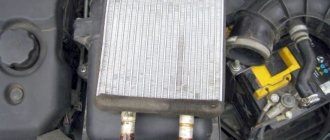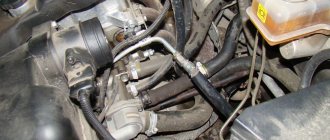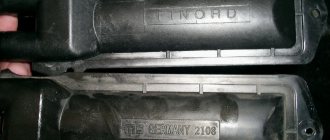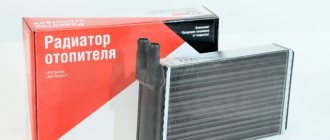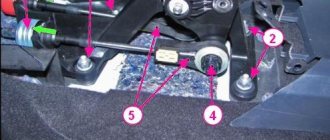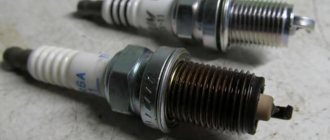In a Lada Vesta car, the stove heats the interior, but as it turns out, this is not its only function. They use it not only in winter, but also in summer. The territory of the Russian Federation is dominated by a temperate climate. In cold winter, the stove becomes an important function on a Lada Vesta car. This unit is necessary in the rain or cold, when you need to quickly remove fogging from the windows and warm up the few moving people in the cabin. In the advanced configuration of the Lada Vesta, the air conditioner can create a comfortable temperature in hot weather. The Lada Vesta stove does its job well. But like in any car, problems happen: the heater radiator leaks, the fan makes noise, or there is vibration. Replacing the stove is important on a Lada Vesta car not only in winter but also in summer. Read the article and you will be warm and comfortable in your car.
The radiator and stove assembly for Vesta look like this
How the stove works on Lada Vesta (process description)
- A small interior radiator is connected through pipes to the engine cooling system, it is from this that the heat comes, and the heater starts working from it;
- The heat received from the radiator is dispersed throughout the cabin by an electric fan, which forces air into the air duct nozzles;
- The resistor (RFV) sets the operating rate of the electric fan;
- The cabin air filter is installed at the outlet of the electric fan;
- A damper is installed in the air ducts, which controls the flow of air reaching passengers;
- The gearmotor moves the air flow distribution damper according to the task;
- And the tasks are distributed by the control unit for the heater (stove) and, if available, the air conditioner. Under the control of the SAUKU unit (heater and air conditioning control unit) there is a fan, gearbox, and various heater sensors.
The SAUKU block looks like this - a typical Vesta classic
Lada
The protective mesh for the Lada radiator grill is not homemade, but made directly for Lada cars. Finished product with a 2-year paint guarantee, with special T-shaped fasteners.
The radiator protection on the Lada is easy to clean from insects, as it is installed on top of the standard radiator grille. Installing radiator protection on a Lada takes less than 10 minutes, the fasteners are modified, anti-vandal T-shaped.
The protective radiator grille for Lada is an ideal solution for those owners who know how important the radiator and the entire cooling system as a whole are for the normal operation of the engine.
It is also possible to install a winter plug to retain heat on the track and warm up faster in sub-zero temperatures.
Radiator protective mesh for Lada, if in the old style then for Zhiguli or VAZ
How much time has passed since the collapse of the USSR, but the Kulibins have not survived in Rus', and this is not bad, the fact that our people can do everything with their own hands, take a file and make a jet plane from a combine harvester, either for a dare, or just for the sake of an interesting pastime , or simply considering that it is more profitable.
Similarly, in our case, many Lada car owners make their own radiator mesh with their own hands, some from the inside of the radiator grille, others from the outside using clamps or similar things. What can you say in this case!? There is time and desire, please, but there are also advantages from the finished product. More on them later!
Who came up with the idea of putting a protective mesh on the radiator of the Lada (formerly Zhiguli, VAZ)!? Yes, we have a patent, but in the short history of the automotive industry this invention has long been in use by the most scrupulous and attentive owners, those who think and know how to care for a car. It was invented by our fathers and grandfathers, they dismantled large oil filters from KAMAZ and installed nets for themselves so that the radiator was always clean, so that God forbid the car would boil!
Now about the advantages of the finished product:
- Time - what is more valuable than time, and how to measure its price, certainly not in rubles or other monetary units, can of course be measured in other material terms, but it is better to measure it in smiles, the smiles of your loved ones! Give them those minutes that others spend inventing the square wheel bicycle. Installing our grid along with ordering on the website will take you no more than 15 minutes.
- Comfort - you are a third-generation inventor, if so, then of course, the complex shape of the radiator grille will be like cutting out a snowflake for a New Year's party at your child's school.
- Prestige - Your car is no longer a Zhiguli, or even a VAZ, it’s time to throw away the key to 12, 13 and 17, 8 to 10 is enough for you.
- Appearance - Your car will be transformed, according to our surveys with an external protective radiator mesh on the Lada, 68% of respondents liked the appearance of the car more.
The choice is yours to drive a Zhiguli or a Lada, a modern car of a successful person who can afford to fill the car with good fuel, pamper his car, keep it clean and be proud of it, love his family and just be a positive person!
Stove malfunctions
Lada Vesta is a warm car. The car should be warm and comfortable. If this is not the case, it means that one of the heater elements has broken down. What problems you may encounter:
- The temperature of the supplied air does not correspond to the declared one (the system does not have enough antifreeze, the radiator of the Lada Vesta stove is clogged, an air lock has formed in the pipes, etc.);
- Vibration of the stove or extraneous noise (most likely this is an electrically driven ventilation device);
- Weak or excessive air flow (dampers are not working properly);
- The heater does not work at all (there may be problems with the electronic control system, serious damage to the heater body, etc.).
Types of carburetors:
- float (most common);
- needle;
- bubbling (quite rare occurrence).
Next we will talk about the Ozone carburetor installed on a VAZ 2107. Let's look at how to clean the carburetor and adjust the VAZ 2107 carburetor. It is worth remembering that some types of carburetors may differ, although they are installed on a similar car model.
- DAAZ 2107-1107010 – VAZ 2105, VAZ 2107.
- DAAZ 2107-1107010-20 – new VAZ 2106, VAZ 2103.
- DAAZ 2107-1107010-10 – previously installed on VAZ 2106 or VAZ 2103 engines without a vacuum corrector, but with an ignition distributor.
The composition of the components of the VAZ 2107 carburetor is as follows:
- autonomous idle system;
- float chamber;
- idle shut-off valve;
- econostat;
- throttle valve;
- dosing system;
- crankcase gas outlet compartment;
- transition tank for both chambers.
Checking the stove fan
The Vesta cabin filter is located above the blades of the unit. The job of the filter element is to collect dust and debris coming from the street. It is possible that these particles may penetrate into the ventilation device. Leaves or pebbles begin to rotate inside the impeller - the fan makes noise.
- To clean it, you need to make access to it free;
- To do this, remove the glove compartment and take out the filter element;
- Now, on the right side of the furnace body we find the mechanism. We clamp the petal located at the top, turn the impeller counterclockwise, and remove the motor;
- We clean the engine with napkins and cotton swabs. One of the reasons for the slowly working mechanism is a dense layer of dust on the walls;
- We install the unit in place and assemble the interior plastic.
There are other typical unit malfunctions. To diagnose them, analyze the operation of the device at different speeds. If one of them does not work, check the wiring and the serviceability of the additional resistor (RFV).
If the Lada fan does not blow at all, the cause may be a blown fuse. Then you don’t need to disassemble anything, just replace the circuit element in the fuse control unit.
What are the disadvantages of understating Vesta?
- Well, naturally, now you will have to drive over bumps more carefully and slowly. There is a risk of the bottom or front bumper hitting bumps and bumps on the road.
- You will also have to be more careful when parking. Opening the doors should also be included in this point; after lowering the VAZ, most likely you will hit the curb with the bottom of the doors.
- Outside the city and on rough terrain, on such a lowered Vesta, you have a very high chance of damaging your car. The road to some places will simply be closed to you. In winter, on untreated roads, your bumper will be more susceptible to damage and act as a snow bucket.
- In winter, most likely, snow will collect and stick in narrower arches, which will one way or another cause you some inconvenience.
Checking the stove dampers
As you already know, air is pumped into the interior of the Lada Vesta by an electric fan through air ducts. It would be possible to drive air directly without using air pipes. However, then it would be impossible to regulate the speed and direction of air flows. For the orderly movement of air masses, an air flow distribution damper is used, which is located between the fan and the outlet from the air duct. There are several of the latter on the dashboard, and accordingly there are the same number of dampers.
Like any mechanism, the dampers that distribute air fail. To detect it, we will check the maximum power of the Lada heating device. This is exactly how the malfunction makes itself felt most easily.
If the volume of incoming gas does not change when moving the mode control lever. This means that the motion limiter does not operate. Most likely, the signal is lost along the way (electric drive). If you hear a creaking or noise when switching the heating mode. Lubricate the dampers with a lubricant containing silicone. Why do windows fog up?
When there is a large difference in temperature or humidity inside the cabin, a coating of water droplets forms on the glass. This is a very dangerous condition - the driver cannot see the road. One of the main functions of the stove is to quickly remove fogging. To do this, several air duct nozzles are directed at the windshield, as well as the side windows of the Lada Vesta. The luxury version also uses heated mirrors.
A working device quickly restores the windows to their normal state. This is achieved by supplying hot air to the surface. Therefore, if Vesta’s windows do not fog up, the reason for this is a faulty radiator.
Gasoline vapor recovery system
The gasoline vapor recovery system (VAPS) consists of a carbon adsorber with a purge solenoid valve and connecting pipelines.
Gasoline vapors from the fuel tank are supplied to a collection tank (adsorber with activated carbon) (Fig. to retain them when the engine is not running. The vapors enter through the pipe marked “TANK”.
The controller, by controlling the solenoid valve, purges the canister after the engine has operated for a specified period of time from the moment it switches to the closed-loop fuel control mode. Air is supplied to the adsorber through the “AIR” pipe, where it is mixed with gasoline vapor. The mixture thus formed is sucked into the engine intake pipe for combustion during the operating process.
The controller regulates the degree of purge of the adsorber depending on the engine operating mode, sending a signal to the valve with a variable pulse frequency (16 Hz, 32 Hz). The controller constantly monitors the effect of purge (the state of the canister being filled with fuel vapor) on engine operation using signal information from the UDC. If the adsorber has a high % filling with fuel vapors, the controller reduces the fuel supply (the value of the parameter “Fuel concentration coefficient in the adsorber” is about 2%, respectively, if the % filling with fuel vapors is low, the value of the parameter “Fuel concentration coefficient in the adsorber” is about 0%). During each trip on a warm engine, the controller checks the condition of the canister purge valve, closing it completely and opening it to a value higher than that set for the given engine operating mode. Based on the deviation of the fuel supply correction factor, the controller determines the condition of the canister purge valve.
The scan tool displays the duty cycle of the control signal. A coefficient of 0% means that the adsorber is not purged. A coefficient of 100% means that maximum purging occurs.
The controller turns on the purge solenoid valve when:
— the coolant temperature is above a certain value;
— the system operates in feedback mode based on the oxygen sensor signal;
- the system is working properly.
Checking heating efficiency
The heater should be checked before the start of the winter season, and also several times in winter. Then troubles will not take you by surprise. To do this, you need to check the operation in all modes and evaluate:
- Does the air heat up and how quickly?
- Does the flow of air masses change with a change in command;
- Are there any extraneous noises?
- In general, are you satisfied with the operation of the heater?
Particular attention should be paid to the same temperature of the pipes. If the difference in the heating of rubber pipelines is significant, this means a serious problem. It's worth finding. In the worst case, this means replacing the Vesta radiator; in the best case, airing or a low level of antifreeze.
Settings
Before you start operating the carburetor from a VAZ 21083 on a VAZ 2106, it must be configured.
In order for the mixture to be prepared better and for you to make adjustments easier, park the car on level ground, without slopes. Start the engine and test it at high and low speeds. This will let you know in which mode the engine receives a normal mixture, and in which it requires adjustment.
After running the engine for a while on the new carburetor and filling its chambers with gasoline, you will need to check what a constant level is in them. To do this, remove the cover from the carburetor, and using a caliper, measure the distance from the fuel level to the top edge of the float chamber. It is best if the level is from 23 to 25 mm. In this case, the carburetor will not flood the spark plugs and stall at idle.
To adjust the fuel level, simply bend the float in the desired direction (up or down). After each change in position, check the resulting distance. When the float is set, assemble the device and begin adjusting the quality and quantity of fuel.
On a VAZ 21083, the correct mixture is obtained with the following settings:
- Quantity screw: 1.5 – 2 turns;
- Quality screw: 4 – 4.5 turns.
After installing it on the VAZ 2106, it is necessary to configure the device after the engine has run at all speeds. And also, the fuel must be heated to operating temperature.
Standard heater radiator
The heater radiator is the same in design as the radiator of the Lada cooling system, only smaller. They have a common antifreeze range. Dirt from the expansion tank may also end up in the small interior assembly. Unfortunately, the radiator cannot be repaired. Need a replacement. When we come closer to the question, it turns out that the standard unit does not have a serial number. There is only a code - UT-00006936, according to which they can sell you another spare part. Therefore, before purchasing, check with the seller for information.
The engine does not idle: the main reason
The first thing you need to pay attention to is the solenoid valve. However, it is not installed on all VAZ 2106 carburetors. It is this small device that most often falls into disrepair
Its operating principle is similar to a solenoid relay - there are windings, an armature, and a return spring, but the dimensions are somewhat smaller.
It is this small device that most often falls into disrepair. Its operating principle is similar to a solenoid relay - there are windings, an armature, and a return spring, but the dimensions are somewhat smaller.
The function of the solenoid valve is to open the path for gasoline to flow (with the throttle valve closed) when the ignition is turned on. And close when disconnected, respectively.
The most common breakdowns of the solenoid valve, as a result of which the idle speed disappears:
- The winding is destroyed, the armature with the needle does not move, fuel is not supplied.
- The fuel nozzle located on the edge of the valve is clogged.
- The valve armature is jammed due to deformation.
You can check this device very quickly; you will need a small piece of wire, stripped from both edges. Connect one end to the positive side of the battery, and connect the other end to the terminal of the solenoid valve. There should be a fairly loud click, but if it doesn’t, then most likely the winding is damaged.
If there is a click, remove the wire connected earlier and turn on the ignition. Place the power connector onto the valve. If there is no click, then the wiring is damaged. In the event of a breakdown, there can be three exits, you can use any:
- If the solenoid valve is completely destroyed, it would be wise to unscrew it and remove the tip (fuel nozzle). And thus get to the nearest store without much difficulty. The price of a new VAZ 2106 solenoid valve is about 100 rubles, so repairs will not be expensive.
- Temporarily connect the output of the solenoid valve to the positive terminal of the battery - if the wiring is damaged. But in this case you will have to remove the wire during each stop.
- It would be much more efficient to run a wire from the solenoid valve output to the “+B” ignition coil contact. The fact is that voltage appears on it only after the ignition is turned on.
Replacing the radiator of the VAZ 21129 Lada Vesta stove
To replace a stove radiator with your own hands:
- It is necessary to turn off the power to the car, free the cooling system from antifreeze;
- Remove the plastic trim of the instrument panel;
- Remove the top panel in the glove compartment, remove the glove compartment;
- The unit is located in the heater block on the driver's side, you need to free access to it - remove the metal pillar of the dashboard frame, remove the air pipe for heating the driver's feet;
- Disconnect the pipes (be prepared for antifreeze leaks);
- Open the cover of the stove device with a Torx screwdriver;
- Remove the heater/cooler from the heater housing;
- Install a new spare part;
- Reassemble the structure in reverse order.
Lada Vesta drives on Russian roads. Passengers should be warm and comfortable. The new AvtoVAZ stove (with a cooling glove compartment for drinks, heating the driver’s feet) copes with its job “excellently”. But any device fails sooner or later. If faults are diagnosed and corrected in time, the device will warm your feet and soul for a long time.
Where is the idle speed sensor on Kalina
Due to its purpose, the product is located directly in the throttle assembly next to the throttle position sensor.
Signs indicating malfunctions
Some signs indicating improper operation of the unit: - problems with starting the engine (it is possible to start only by repeatedly pressing the gas pedal); — floating speed when switching gears to neutral; — when changing gears, the car stalls completely or choke; — it is difficult to warm up the engine in the cold season (engine speed does not increase above 1500 rpm); — when additional energy consumers are turned on (stove, air conditioning, heating and others), the idle speed is lower than the operating values, or constantly floats.
If you observe one or more of the above situations, pay attention to the idle speed sensor for the 8 valve Kalina and carry out diagnostic measures.
WHY DO GLASSES FOG?
The car windows should not fog up while the heater is operating If this happens, then the cause may be:
- heater core leaking
- cabin filter is clogged
- The electric recirculation air damper actuator is faulty
No matter what AVTOVAZ PR people say, the LADA Vesta, in accordance with the traditions of the Soviet automobile industry of the last century, turned out to be a “crude” car - with a lot of design flaws and quality defects. One of the global “jambs” that causes a lot of complaints - the clutch and manual gearbox - AVTOVAZ has already begun to change it to “more different ones”. It is not yet known whether this step will remove the claims of car owners about their reliability and smooth operation. It’s good that the company, although a year late, is trying to make its car better.
Why does the Lada Vesta, XRAY stove blow cold air - 2 reasons
Question about the Lada Vesta car, XRAY: “Please, why on the Vesta did the stove start blowing cold air from the right side? And from the left side there is warm/hot air. What could be the reason?". As it turned out, many owners of this car face a similar problem. There may be several reasons.
Glove compartment cooling
There is a damper in the left wall of the lid box, from which cold air flows in to cool its contents. During winter, this valve should be closed by turning it.
Also make sure that the hose leading to the damper is tight. There are cases when the glove compartment cooling tube has cracked. The problem can be solved by replacing the tube or modification.
Heater radiator
If hot air is blowing from the left air ducts (including into the legs), and barely warm or cold air from the right ones (for the front passenger), then the possible cause is the heater radiator. Even on short runs it can become clogged, which impairs the circulation of antifreeze and reduces the efficiency of the stove.
Solution
: If the car is under warranty, contact the dealership with the problem. There were cases when the heater radiator was replaced under warranty and the engine cooling system was cleaned. You can perform these same procedures yourself.
Spring for the damper?
They also put a spring on the heater damper so that it presses it better in the “frontal-legs” mode:
It is believed that some of the air was blown onto the windshield to prevent fogging. This modification to the springs can lead to wear of the climate damper servomotor, and then its further failure.
Dismantling
To remove the radiator of the Lada Vesta stove, you first need to prepare the car. It will be more convenient to carry out work in an inspection hole or with a lift. If such an opportunity exists, then you should not miss it. After this, you can proceed to dismantling the radiator mechanism.
- Disconnect the negative terminal from the battery pack.
- We remove the engine protection and the front bumper.
- Now you can move on to the front bumper beam, which also needs to be dismantled.
- We press out the clamps.
- Disconnect the pipe from the air intake from the air deflector.
- We release the clamps and disconnect the temperature sensor from the air deflector mechanism.
- We press out the latches that make it difficult to dismantle the air deflector panel.
- We drain the coolant that fills the heater radiator of the Lada Vesta.
- We open the fastening clamps to be able to disconnect the supply hose from the thermostat pipes and the pipe that supplies the water pump. And it is also worth disconnecting the steam removal hose, which connects to the pipe on the expansion tank. You will need pliers here.
- We cut the clamps that secure the hoses to the upper cross member on the radiator frame.
- Disconnect the connectors on the wire bundle in front from the connectors on the fan, sound and radiator fan relay unit.
- We cut the clamp of the front bundle of wires, which is attached to the fan casing.
- Owners of cars with an air conditioning system should release the locking elements, turn it off and move it to the side. This is the only difference in replacing the radiator of models with air conditioning from conventional cars.
- Rotate the radiator mounting clips, which then need to be removed from the brackets.
- We remove the radiator along with the fan and hoses.
- We press out the clamps that hold the cooling system fan of the power unit.
Problems with the VAZ 21116 engine
This is an improved power unit from the VAZ 21114. The connecting rod and piston group was lightened by 40%, replacing the materials with aluminum alloy. If the belt drive breaks, the valve heel does not bend.
Engine design features
- the valve mechanism must be adjusted at intervals of 45,000 km;
- the oil filter needs to be changed more often than other models (10,000 km);
- rapid wear of the cooling system elements occurs;
- Frequent engine oil leaks occur due to depressurization of sealing gaskets;
- The clamping nuts on the exhaust exhaust pipe burst and need to be replaced with brass ones.
Typical faults
- Detonation during operation: measure the compression in each cylinder. A deviation of 1.0 atmospheres or more is a sign of valve burnout. A difference of up to 1.0 atmospheres is a sign of wear on the rings or damage to the sealing gasket.
- Unstable speed: diagnose the throttle position sensor, adjust idle speed.
- The engine temperature does not rise above 40°: the thermostat is faulty, replace it with a new one.
- Uncharacteristic knocks and noises when the engine is running: a metallic knock is a sign of a malfunction of the connecting rods and crankshaft bearings. Piston knocking is less common. To troubleshoot the problem, contact a service station for help.
Brand name – LRh – Luzar Radiator heater
Heating radiators (also known as heater radiators, also known as heater radiators) are heat exchangers that use the heat generated by the engine to heat the vehicle interior. They allow you to maintain a comfortable temperature and prevent the car windows from fogging up.
For reference: different names of this node have equal rights of use. For example, “heating radiator” and “stove” come from the function of this heat exchanger, “heater radiator” and “stove radiator” - from the installation location.
LUZAR manufactures hundreds of heater radiators for a wide range of cars presented on the Russian market. They can be purchased in partner stores throughout Russia or online.
Many models of heater radiators are supplied to car factories in Russia and Ukraine - both for passenger cars and for trucks and buses.
The production range of manufactured stoves is constantly increasing; New types are being developed for the most popular cars in Russia.
Powerful R&D allows us to conduct research in the field of improving heat exchangers and create new designs that provide increased performance properties of heater radiators. Main areas of research:
- use of different types of tubes
- changing the location of the tubes
- change in the “fillability” of the core
- use of turbulators-swirlers
- use of various aluminum alloys
- testing of solders with different characteristics
- improving the corrosion properties of metal
- ... and many other R&D areas.
